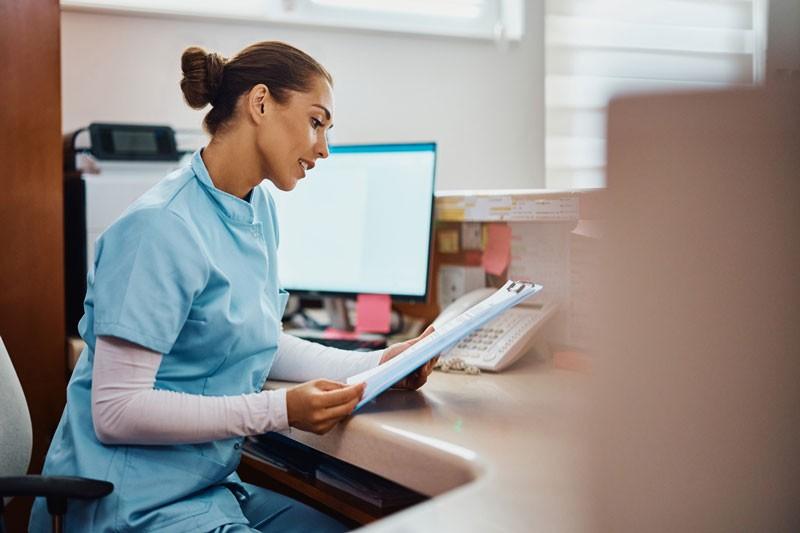Top 10 Essential Duties of a Medical
Receptionist: The Backbone of Every Healthcare Practice
A medical receptionist plays a pivotal role in any healthcare facility, bridging the gap between patients, clinical staff, and administrative operations. When recruiting or training one, it’s important to understand the the top 10 essential duties of a medical receptionist—these form the backbone of their daily contributions.

Below, we explore each duty in detail, illustrating how a competent receptionist elevates patient care and ensures a smoothly running medical practice.
1. Greeting and welcoming patients
One of the most visible and first impressions a patient gets is from the person behind the front desk. A medical receptionist must greet patients and visitors—both in person and via phone— with a warm, professional manner. This duty includes directing them to the correct department, providing waiting time estimates, and answering basic inquiries. First impressions matter; a friendly greeting helps calm anxious patients and sets the tone for the visit.
2. Appointment scheduling and calendar management
Efficient scheduling is essential to avoid bottlenecks in a clinic’s workflow. The receptionist coordinates with physicians, nurses, and support staff to slot patients appropriately, balancing urgent visits with routine follow-ups. They must also manage cancellations, no-shows, and rescheduling. A proactive receptionist often sends reminders or confirmations to reduce absenteeism.
3. Check-in and registration of patients
Upon arrival, patients must be checked in and registered accurately. This includes verifying personal information, demographic data, and ensuring paperwork is completed (such as consent forms or medical history updates). The receptionist also ensures all required documents are collected or completed before the patient is seen by clinicians, reducing delays or omissions later.
4. Insurance verification and eligibility checks
Before services are rendered, verifying patients' insurance coverage and confirming eligibility is critical to avoid billing surprises. A medical receptionist often liaises with insurance companies, verifies coverage limits or exclusions, and obtains authorization or referrals when required. This prevents denied claims and ensures the facility is reimbursed properly.
5. Billing, payments, and handling co-payments
Collecting payments, co-payments, or outstanding balances is often part of the receptionist’s function. They may also assist in preparing and submitting patient invoices, coordinating with billing departments, and addressing basic questions about charges. Accurate financial handling reduces revenue leakage and builds patient trust.
6. Managing patient records and electronic health records (EHR)
Maintaining accurate and up-to-date patient files—whether physical or digital—is a key responsibility. The receptionist ensures that new entries, test results, referrals, and correspondence are filed appropriately. In modern clinics, working with EHR systems is standard; updating, retrieving, and reconciling records forms a large part of the job.
7. Answering phone calls and handling inquiries
Medical offices receive a high volume of inbound calls, many with urgent or complex needs. The receptionist screens, transfers, or responds to queries about appointments, billing, or medical
instructions. They must triage calls effectively—escalating emergencies to clinical staff when needed and providing clear, calm information to callers.
8. Coordination and communication with clinical staff
A receptionist must act as a liaison between patients, doctors, nurses, lab personnel, and other departments. This includes notifying the physician when a patient arrives, alerting staff of changes or delays, and coordinating referrals or lab orders. Seamless communication is essential to prevent missteps in patient care.
9. Inventory, supplies, and office upkeep
While less visible, maintaining inventory (such as forms, office supplies, medical consumables) and ensuring the front-desk area is organized and clean is an important duty. The receptionist tracks stock levels, reorders supplies, schedules equipment maintenance, and ensures the waiting and reception areas remain presentable.
10. Confidentiality, compliance, and quality assurance
Finally, medical receptionists must adhere to privacy and data protection regulations (like HIPAA in the U.S.), safeguarding sensitive patient information. They must also follow clinic policies, procedures, and quality standards—reporting discrepancies, helping with audits, and maintaining documentation compliance. Professionalism in handling confidentiality builds trust and reduces legal risk.
Why these duties matter
These top 10 essential duties of a medical receptionist are interdependent. When executed well, they contribute not only to smoother patient flow but also to reduced errors, higher patient satisfaction, and better revenue management. In a busy clinic, a skilled receptionist can be a difference-maker—helping clinicians focus on care rather than chaos.
If you're looking to outsource or augment your front-office operations, consider partnering with a solution like Portiva (visit portiva.com) which helps medical practices manage administrative workloads efficiently and reliably. A strong front desk foundation allows clinics to focus more on healing and less on paperwork.

In sum, a medical receptionist is much more than someone who answers phones and greets visitors. They are an operational linchpin whose work quietly supports clinical excellence, patient experience, and financial health. Understanding and appreciating these ten duties will help any healthcare facility hire the right person—or support their existing team’s growth and performance.
